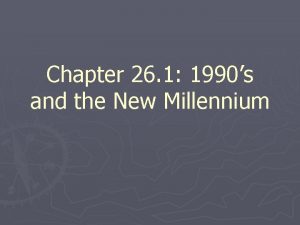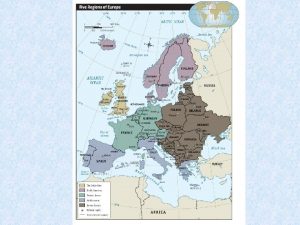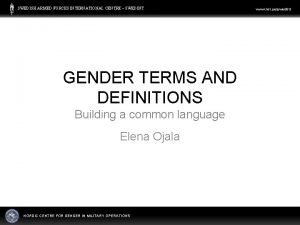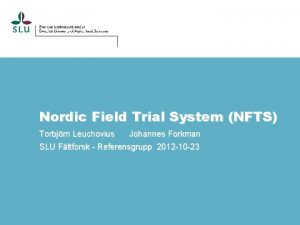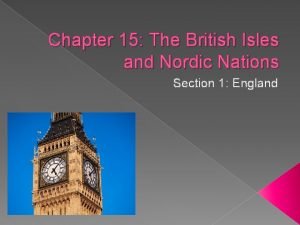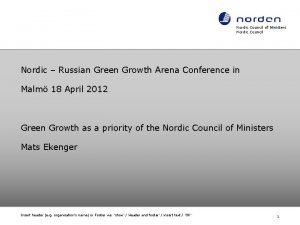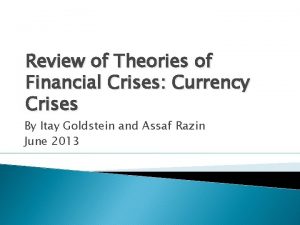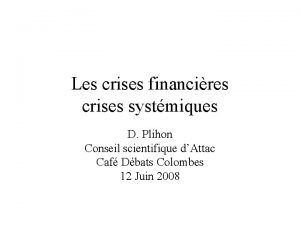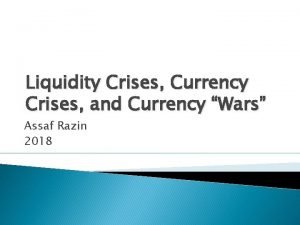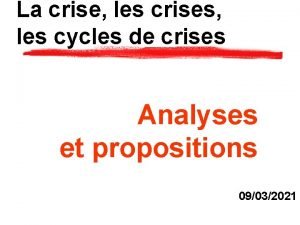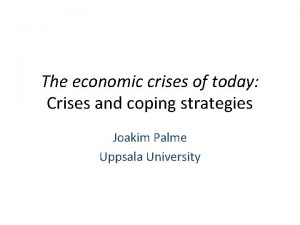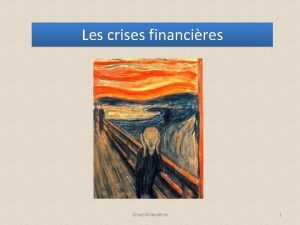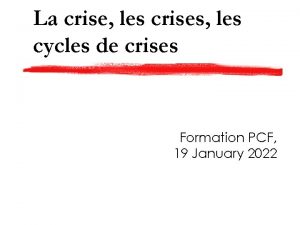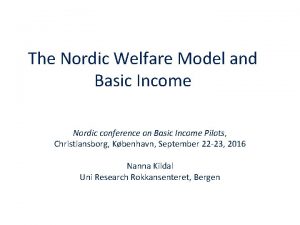The 1990s Financial Crises in Nordic Countries Financial































- Slides: 31

The 1990’s Financial Crises in Nordic Countries "Financial Markets and the Macroeconomy: Challenges for Central Banks", Sveriges Riksbank, 6 November 2009 Seppo Honkapohja, Bank of Finland SUOMEN PANKKI | FINLANDS BANK | BANK OF FINLAND 1

I. Introduction ¨ 19 crises in advanced countries since WWII before the current one. ¨ 1990’s crises in Finland, Norway and Sweden are among the ”big five”. ¨ In 1990 -93 bank loss provisions (of lending): 2. 9 % in Denmark, 3. 4 % in Finland, 2. 7 % in Norway 4. 8 % in Sweden SUOMEN PANKKI | FINLANDS BANK | BANK OF FINLAND 2

¨ All Nordic countries provided public support to their banks. ¨ Crises in Finland, Norway, and Sweden became systemic. ¨ Crisis remained non-systemic in Denmark. SUOMEN PANKKI | FINLANDS BANK | BANK OF FINLAND 3

Outline of Talk ¨ ¨ Main developments Reasons for the crises Crisis management Lessons -------------¨ My perspective SUOMEN PANKKI | FINLANDS BANK | BANK OF FINLAND 4

II. Main Developments II. 1 The Real Economies SUOMEN PANKKI | FINLANDS BANK | BANK OF FINLAND 5

Finland Sweden ¨ ¨ Overheating in 2 nd half of 1980’s Recession with negative growth in early 1990’s Recovery, then good performance Note: Finnish developments more extreme --------------¨ Norway had an earlier upswing, recession in 1987, but no (significant) negative growth. ¨ Fairly slow recovery, then good performance SUOMEN PANKKI | FINLANDS BANK | BANK OF FINLAND 6

SUOMEN PANKKI | FINLANDS BANK | BANK OF FINLAND 7

Current account ¨ Finland had major CA deficits in 1980 s and early 1990 s. ¨ Smaller but fairly persistent CA deficits for Sweden. ¨ Norway had CA surpluses, except in 2 nd half of 1980 s after decline of oil prices in 1986. SUOMEN PANKKI | FINLANDS BANK | BANK OF FINLAND 8

II. 2 Financial developments SUOMEN PANKKI | FINLANDS BANK | BANK OF FINLAND 9

SUOMEN PANKKI | FINLANDS BANK | BANK OF FINLAND 10

House prices ¨ Strong boom and subsequent decline in Finland Norway ¨ Long decline in Norway ¨ less pronounced and slow movements in Sweden Stock prices ¨ Strong movements in Finland Sweden in late 80’s and early 90’s ¨ Little movement in Norway during the boom and crisis SUOMEN PANKKI | FINLANDS BANK | BANK OF FINLAND 11

SUOMEN PANKKI | FINLANDS BANK | BANK OF FINLAND 12

Bank lending (percent of GDP) ¨ Strong increase during the 80’s boom ¨ Major decline with the onset of the recession ¨ Finland Sweden had negative lending growth for 2 -3 years in early 90’s. SUOMEN PANKKI | FINLANDS BANK | BANK OF FINLAND 13

SUOMEN PANKKI | FINLANDS BANK | BANK OF FINLAND 14

SUOMEN PANKKI | FINLANDS BANK | BANK OF FINLAND 15

SUOMEN PANKKI | FINLANDS BANK | BANK OF FINLAND 16

III. Reasons for the Crises ¨ Focus on Finland (deepest crisis) III. 1 Boom § Finnish boom caused by – financial market deregulation (with problematic elements) – Freeing of capital movements, with attempt to tight monetary policy under fixed exchange rate – Upswing in western economies (bad timing) § Swedish boom similar, but milder § Norway: boom cut short by oil price decline in 1986 SUOMEN PANKKI | FINLANDS BANK | BANK OF FINLAND 17

III. 2 Bust ¨ Negative international shocks – slow growth in the west – collapse of Soviet Union -> huge decline in trade with Russians – German unification led to high real interest rates (Figures) ¨ Domestic policy – Domestic monetary policy very restrictive because of defence of fixed exchange rate ¨ Finland started to recover in 1993 -94 SUOMEN PANKKI | FINLANDS BANK | BANK OF FINLAND 18

SUOMEN PANKKI | FINLANDS BANK | BANK OF FINLAND 19

SUOMEN PANKKI | FINLANDS BANK | BANK OF FINLAND 20

¨ The recession was largely similar but smaller in Sweden, except Sweden had no trade with Soviet Union. ¨ Swedish industry was also more modernized than Finnish industry. ¨ Norway: recession in 1987 -88 because of oil price decline and restrictive policies; only slow recovery SUOMEN PANKKI | FINLANDS BANK | BANK OF FINLAND 21

III. Reasons for the Crisis ¨ Problems in financial deregulation – bad timing with international business cycle upswing – Bank laws and bank supervision were outdated (tightening only in 1991) – tax system favored debt financing – lending rates freed before deposit rates – fixed exchange rate system ¨ International dimension for Finnish and Swedish crises => ”twin crises” SUOMEN PANKKI | FINLANDS BANK | BANK OF FINLAND 22

IV. Crisis management ¨ Finland – 1 st measure: Bank of Finland took control of Skopbank in September 1991. – Public support: preferred capital certificates to banks, with strict requirements – Support to be converted into shares if not repaid – Government set up a crisis management agency. – Policy-makers made promises to guarantee banks’ obligations, also further public support. SUOMEN PANKKI | FINLANDS BANK | BANK OF FINLAND 23

¨ Finland (continued) – Banks became profitable again in 1996 – Improved efficiency (staff halved, etc. ) – Major restructuring of banking system: • savings banks largely disappeared, • one big commercial bank was merged to another – Nowadays about 60 percent of banks owned by foreigners => Biggest part of the crisis was in Savings Banks. SUOMEN PANKKI | FINLANDS BANK | BANK OF FINLAND 24

¨ Sweden – Crisis erupted in autumn 1991 with Första Sparbanken; government gave a loan and FS merged with other savings banks. – Nordbanken (3 rd largest comm. bank) was 71% govt owned and had to be recapitalized. – Many banks made heavy credit losses. – In autumn 1992 blanket creditor guarantee by government. – Crisis resolution agency set up, public support with strict criteria in risk reduction and efficiency. – Some banks did not need public support. Þ In the end nearly all support went into two banks, Gotabanken and Nordbanken. - Nordbanken became a pan-Nordic bank ”Nordea”. SUOMEN PANKKI | FINLANDS BANK | BANK OF FINLAND 25

¨ Norway – Crisis erupted in autumn 1988. – Initially private guarantee funds provided support and bank mergers took place. – In late 1990 private funds were exhausted, so government guarantee funds set up in early 1991. – Support had to be converted into solvency support. – In autumn 1991 capital support needed. – In Spring 1992 several banks, incl. three biggest commercial banks were nationalized. SUOMEN PANKKI | FINLANDS BANK | BANK OF FINLAND 26

¨ Norway (continued): – no blanket guarantee by government, but specific announcements about securing depositors and creditors – Banks situation started to improved in 1993. – One of nationalized banks was sold in 1995 and two other banks were sold later. – Government still owns 34 percent of one bank (in 2008). => In the end the Norwegian tax payer made money out of the crisis (not so in Finland Sweden). SUOMEN PANKKI | FINLANDS BANK | BANK OF FINLAND 27

Fiscal costs of the banking crises (Sandal 2004) Finland Norway Sweden Gross cost Net cost 9. 0 (% of 1997 GDP) 2. 0 (% of 1997 GDP), 5. 3 (% of 1997 GDP) 3. 4 (present value , % of 2001 GDP) -0. 4 (present value, % of 2001 GDP) 0. 2 (% of 1997 GDP) 3. 6 (% of 1997 GDP) SUOMEN PANKKI | FINLANDS BANK | BANK OF FINLAND 28

V. Lessons ¨ Prevention of major crisis is first priority => stabilityoriented macro policies ¨ How to diagnose an overheating situation? – rapid credit expansion – strong increase in leverage – big external deficits in open economies ¨ Political-economy reasons can be a major obstacle in prevention. SUOMEN PANKKI | FINLANDS BANK | BANK OF FINLAND 29

¨ Crisis management – Maintaining confidence in banking system is crucial. – Bipartisan political support; political guarantees to banks’ obligations in Finland Sweden but not in Norway. ¨ Role of central banks – Liquidity support in Norway and Sweden – Bank of Finland had to take over a problem bank. SUOMEN PANKKI | FINLANDS BANK | BANK OF FINLAND 30

¨ Crisis resolution agencies in all three countries - Administrative separation from central bank and ministry of finance. - Capital injections to banks - Guiding of restructuring of the banking system - Treatment of ”old shareholders” was mixed ¨ Asset management companies (”bad banks”) to deal with non-performing assets – Norway: banks had their own bad banks – Finland Sweden had public agencies => Nordic practices in crisis resolution have been praised afterwards. SUOMEN PANKKI | FINLANDS BANK | BANK OF FINLAND 31
 Mouse meervoud
Mouse meervoud The crises
The crises Search by image
Search by image School curriculum in the 1990s
School curriculum in the 1990s Chapter 26 section 1 the 1990s and the new millennium
Chapter 26 section 1 the 1990s and the new millennium Yugoslavia only existed from the 1940s to the 1990s because
Yugoslavia only existed from the 1940s to the 1990s because World wide web 1990s
World wide web 1990s World wide web 1990s
World wide web 1990s 1990s in film
1990s in film The british isles and nordic nations map
The british isles and nordic nations map Nordic walking warm up
Nordic walking warm up Westfjord 29 nordic
Westfjord 29 nordic Nordic hiit proff
Nordic hiit proff Swedint
Swedint Nordic walking wymowa po polsku
Nordic walking wymowa po polsku Rsmp protocol
Rsmp protocol Norse constellations
Norse constellations Innovation procurement european commission
Innovation procurement european commission Ucla grad school
Ucla grad school Nordic combat uniform system
Nordic combat uniform system Language translator online
Language translator online Nordic body map
Nordic body map Nooksack nordic ski club
Nooksack nordic ski club Pocket creek
Pocket creek Nordic-backup
Nordic-backup Nordic field trial system
Nordic field trial system Nordic trout ab
Nordic trout ab Nordic ecolabel criteria
Nordic ecolabel criteria British isles and nordic nations map
British isles and nordic nations map Nordic finance and the good society
Nordic finance and the good society Magento dhl
Magento dhl Nordic clinical
Nordic clinical




